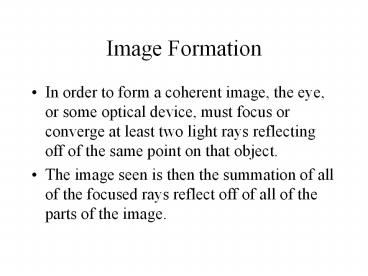Image Formation - PowerPoint PPT Presentation
Title:
Image Formation
Description:
Image Formation In order to form a coherent image, the eye, or some optical device, must focus or converge at least two light rays reflecting off of the same point on ... – PowerPoint PPT presentation
Number of Views:187
Avg rating:3.0/5.0
Title: Image Formation
1
Image Formation
- In order to form a coherent image, the eye, or
some optical device, must focus or converge at
least two light rays reflecting off of the same
point on that object. - The image seen is then the summation of all of
the focused rays reflect off of all of the parts
of the image.
2
Virtual images vs. Real images
- Real Image Light rays from the same point
intersect in real space on a ray diagram. Real
images created by single converging lenses are
inverted in most cases. The image formed by a
human eye is a great example of this - Virtual Image No actual intersection. Image
formed behind lens/mirror.
3
Eyeball
Mirror
4
Converging Optics focus parallel light rays to
a single point
- Converging Mirrors
- Always concave in shape
- Real images form when ogtf
- Virtual images form when oltf
- Converging Lenses
- Always convex in shape
- Always form real images
5
Converging lenses
Convex surface
6
Diverging Optics separate parallel light rays
so that they NEVER intersect
- Diverging Mirrors
- Always convex in shape
- Images always virtual
- Diverging Lenses
- Always concave in shape
- Always form virtual images
7
Diverging Lenses
Concave surface
8
Lens Vocabulary
9
Relationship between variables
Distance between object and optic
Focal length
Distance between image formed and optic
Magnification
10
An important note
- The image distance for virtual images is ALWAYS
negative in the lens equation. - Be very careful with this. Dropping this
negative can mess up your whole calculation.
11
Drawing ray diagrams
- Draw a principal axis such that this line will
pass through the center of the optical component,
perpendicular to the optic. - Draw the object as an erect (upright) arrow on
the left side of the optic. - --The height of the arrow will be proportional to
the objects real size and its distance from the
optical component proportional to the real
distance, o.
12
Finding images on a ray diagram(Converging
optics ONLY)
- Incident ray parallel to principal axiscomes out
through the focal point. - Incident ray into optics through focal
pointcomes out parallel to the principal axis. - Draw image at point of intersection of rays.
- Other rays can be drawn. (e.g., centerstraight
reflection/refraction, etc..)
13
Finding images on a ray diagram(Diverging optics
ONLY)
- Incident ray parallel to principal axiscomes out
through the focal point. Extend the point of
interface behind the optic, through the focal
point. - 2nd ray will be drawn to pass directly through
the center of the lens/off the center of the
mirror. - Draw image at point of intersection of rays.
14
- Note that both types of optical components follow
the same rules. - We will study these in more detail in the coming
days.
15
Ray Diagrams A real image
f1 f2 o i































